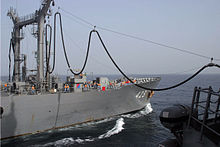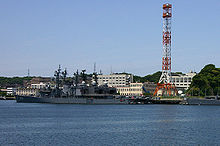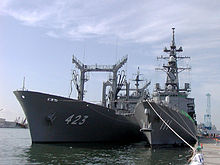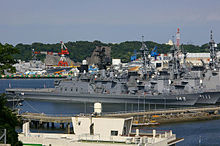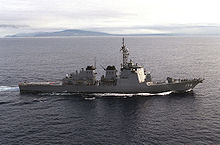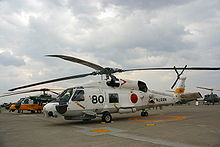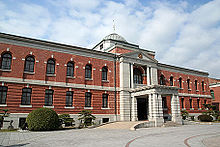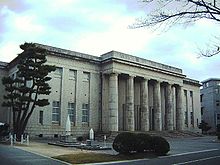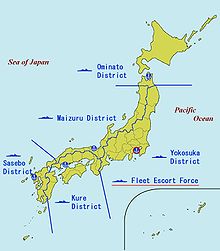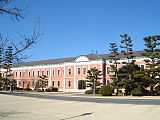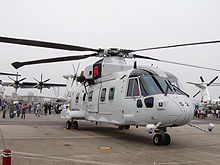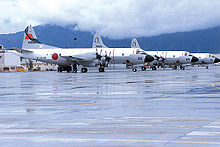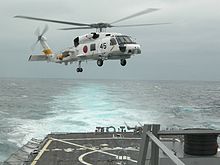- Japan Maritime Self-Defense Force
-
Japan Maritime Self-Defense Force
(JMSDF)
海上自衛隊
(Kaijō Jieitai)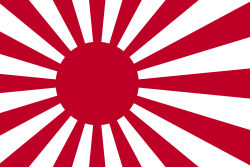
Rising Sun FlagFounded 1952 Allegiance  Japan
JapanType Navy Role Defend Japanese territorial waters and shipping Size 45,800 personnel
110 ships
314 aircraftGarrison/HQ Yokosuka, Japan The Japan Maritime Self-Defense Force (海上自衛隊 Kaijō Jieitai), or JMSDF, is the naval branch of the Japan Self-Defense Forces, tasked with the naval defense of Japan. It was formed following the dissolution of the Imperial Japanese Navy (IJN) after World War II.[1] The JMSDF has a large fleet with significant blue-water operating capabilities. Its main tasks are to maintain control of the nation's sea lanes and to patrol territorial waters. It has also stepped up its participation in UN-led peacekeeping operations (PKOs) and Maritime Interdiction Operations (MIOs).
The JMSDF has an official strength of 46,000 personnel (currently around 45,800 personnel), operating some 110 major warships, including 4 helicopter carriers, 16 submarines, 44 destroyers and frigates, 29 mine warfare ships, 9 patrol craft and 9 amphibious ships (total displacement of approx. 432,000 tons).[2] It also has 179 fixed-wing aircraft and 135 helicopters. Most of these aircraft are used in antisubmarine and mine warfare operations.[3]
The ship prefix for JMSDF ships is JDS (Japanese Defense Ship) for all ships commissioned before 2008. Ships commissioned on or after 2008 will use the prefix JS (Japanese Ship) to reflect the upgrading of the Japanese Defense Agency to the Ministry of Defense.
Contents
History
Japan Maritime Self-Defense Force
日本国 海上自衛隊 (Kaijō Jieitai)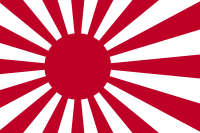
Components Self Defense Fleet Fleet Escort Force Fleet Air Force Fleet Submarine Force District Force JMSDF Reserve Command Maritime Staff Office History Naval history of Japan Imperial Japanese Navy History of Japan Maritime Self-Defense Force Personnel Rank insignia of the JMSDF Ships List of combat ships of JMSDF Ships of the JMSDF Origin
Main article: Naval history of Japan Naval battle of Dan-no-Ura in 1185
Naval battle of Dan-no-Ura in 1185
Japan has a long history of naval interaction with the Asian continent, involving transportation of troops, starting at least with the beginning of the Kofun period in the 3rd century. Following the attempts at Mongol invasions of Japan by Kubilai Khan in 1274 and 1281, Japanese wakō became very active in plundering the coast of the Chinese Empire.
Japan undertook major naval building efforts in the 16th century, during the Warring States period, when feudal rulers vying for supremacy built vast coastal navies of several hundred ships. Around that time, Japan may have developed one of the world's first ironclad warships, when Oda Nobunaga (a Japanese daimyo) had six iron-covered Oatakebune made in 1576.[4][5]
In 1588, Toyotomi Hideyoshi issued a ban on Wakō piracy; the pirates then became vassals of Hideyoshi and comprised the naval force used in the Japanese invasion of Korea.
Japan built her first large ocean-going warships in the beginning of the 17th century, following contact with European countries during the Nanban trade period. In 1613, the Daimyo of Sendai, in agreement with the Tokugawa Bakufu, built the Date Maru. This 500 ton galleon-type ship transported the Japanese embassy of Hasekura Tsunenaga to the Americas and Europe. From 1604 onwards, about 350 Red seal ships, usually armed and incorporating European technology, were also commissioned by the Bakufu, mainly for Southeast Asian trade.
 The British-built Ryūjō was the flagship of the Imperial Japanese Navy until 1881.
The British-built Ryūjō was the flagship of the Imperial Japanese Navy until 1881.
From 1868, the restored Meiji Emperor continued with reforms to industrialize and militarize Japan to prevent the United States and European powers from overwhelming it. On 17 January 1868, the Ministry of Military Affairs was established, with Iwakura Tomomi, Shimazu Tadayoshi and Prince Komatsu-no-miya Akihito as the First Secretaries.
On 26 March 1868, the first Naval Review was held in Japan (in Osaka Bay), with 6 ships from the private domainal navies of Saga, Chōshū, Satsuma, Kurume, Kumamoto and Hiroshima participating. The total tonnage of these ships was 2252 tons, far smaller than the tonnage of the single foreign vessel (from the French Navy) that also participated. The following year, in July 1869, the Imperial Japanese Navy was formally established, two months after the last military engagement of the Boshin War. In July 1869, the private navies of the Japanese nobles were abolished, and their 11 ships were added to the 7 surviving vessels of the defunct Tokugawa bakufu navy, including the Kankō Maru, Japan's first steam warship.[6] This formed the core of the new Imperial Japanese Navy.
An 1872 edict officially separated the Japanese Navy from the Japanese Army. Politicians like Enomoto Takeaki set out to use the Navy to expand to the islands south of Japan in similar fashion to the Army's northern and western expansion. The Navy sought to upgrade its fleet to a blue water navy and used cruises to expand the Japanese consciousness on the southern islands. Enomoto's policies helped the Navy expand and incorporate many different islands into the Japanese Empire, including Iwo Jima in 1889. The navy continued to expand and incorporate political influence throughout the early twentieth century.[7]
Formation of the Japanese Maritime Self-Defense Force
Following the defeat of Japan during World War II, the Imperial Japanese Navy was dissolved by the Potsdam Declaration acceptance. Ships were disarmed, and some of them, such as battleship Nagato, were taken by the Allied Powers as reparation. The remaining ships were used for repatriation of the Japanese soldiers from abroad and also for minesweeping in the area around Japan. The minesweeping fleet was eventually transferred to the newly-formed Maritime Safety Agency, which helped maintain the resources and expertise of the navy.
Japan's 1947 Constitution was drawn up after the conclusion of the war, Article 9 specifying that "The Japanese people forever renounce war as a sovereign right of the nation and the threat or use of force as a means of settling international disputes." The prevalent view in Japan is that this article allows for military forces to be kept for the purposes of self-defense. Due to Cold War pressures, the United States was also happy for Japan to provide part of its own defense, rather than have it fully rely on American forces.
In 1952, the Coastal Safety Force was formed within the Maritime Safety Agency, incorporating the minesweeping fleet and other military vessels, mainly destroyers, given by the United States.
In 1954, the Coastal Safety Force was separated, and the JMSDF was formally created as the naval branch of the Japanese Self-Defense Force (JSDF), following the passage of the 1954 Self-Defense Forces Law.
The first ships in the JMSDF were former US Navy destroyers, transferred to Japanese control in 1954. In 1956, the JMSDF received its first domestically produced destroyer since World War II, the Harukaze. Due to the Cold War threat posed by the Soviet Navy's sizable and powerful submarine fleet, the JMSDF was primarily tasked with an anti-submarine role.
Post Cold War
Following the end of the Cold War, the role of the JMSDF has vastly changed. In 1991, after much international pressure, the JMSDF dispatched minesweepers to the Persian Gulf in the aftermath of the Gulf War to clear mines sown by Saddam Hussein's defending forces;[8] and starting with a mission to Cambodia in 1993 when JSDF personnel were supported by the JDS Towada,[8] it has been active in a number of UN-led peace keeping operations throughout Asia. In 1993, it also commissioned its first Aegis-equipped destroyer, the DD173 Kongō. It has also been active in joint naval exercises with other countries, such as the United States. The JMSDF has dispatched a number of its destroyers on a rotating schedule to the Indian Ocean in an escort role for allied vessels as part of the US-led Operation Enduring Freedom.
Following an increase in tensions with North Korea following the 1993 test of the Nodong-1 missile and the 1998 test of the Taepodong-1 missile over northern Japan, the JMSDF has stepped up its role in air defense. A ship-based anti-ballistic missile system was successfully test-fired on 18 December 2007 and has been installed on Japan's Aegis-class destroyers. The JMSDF along with Japan Coast Guard has also been active in preventing North Korean infiltrators from reaching Japan and at one time, engaged and sank a North Korean spyship in 2001.
Capabilities and recent developments
Japan has the 7th largest Exclusive Economic Zone (EEZ) in the world,[9] and the JMSDF is responsible for protecting this large area. As an island nation, dependent on maritime trade for the majority of its resources, including food and raw materials, maritime operations are a very important aspect of Japanese defense policy.
The JMSDF is known in particular for its anti-submarine and mine-sweeping capability. Defense planners believe the most effective approach to combating submarines entails mobilizing all available weapons, including surface combatants, submarines, aircraft and helicopters. Historically the JASDF has been relied upon to provide air cover at sea, a role that is subordinate to JASDF's primary mission of air defense of the home islands. Extended patrols over sea lanes are beyond the JASDF's current capabilities.
The fleet's capacity to provide ship-based anti-air protection is limited by the absence of aircraft carriers, though its Aegis-equipped destroyers provide a formidable capability in anti-air warfare. The fleet is also short of underway replenishment ships and generally deficient in all areas of logistic support. These weaknesses seriously compromise the ability of the JMSDF to fulfill its mission and operate independently of the United States Air Force and the United States Seventh Fleet. However, these capabilities are force multipliers, allowing force projection of Japan's sizable destroyer and frigate force far from home waters, and acquiring them is contentious considering Japan's "passive" defense policy.
 JDS Hyuga, a Hyūga class helicopter carrier
JDS Hyuga, a Hyūga class helicopter carrier
In August 2003, a new "helicopter destroyer" class was ordered, the Hyūga class helicopter destroyer. The size and features of the ship, including a full length flight deck, will result in it being classified as either an amphibious assault ship, or helicopter carrier by Lloyd's Register, similar to HMS Ocean (L12). It has been widely disputed if a carrier of any sort would be technically prohibited by Article 9 of the Japanese Constitution, as carriers are generally considered offensive weapons. In an April 1988 Diet budget session, then Defense Agency chief Tsutomu Kawara said that "The Self-Defense Forces are not allowed to possess ICBMs (intercontinental ballistic missiles), strategic bombers, or attack aircraft carriers."[citation needed]
Until the 1970s in the US Navy, large-scale flattops had been categorized as "attack aircraft carriers" and small flattops as "anti-submarine aircraft carriers." Since helicopter carriers have little organic attack capability and primarily fulfill roles including logistics and transport, the government continues to argue that the prohibition does not extend to the new ship.
In November 2009 the JMSDF announced plans for a even larger "helicopter carrier" though this has not yet been approved by the Japanese Government.[10][11]
The JMSDF's submarine fleet consists of one of the most technologically advanced and capable diesel-electric forces in the world. This is due to careful defense planning in which boats are routinely retired ahead of schedule and replaced by increasingly advanced models.[12] In 2010 it was announced that the Japanese submarine fleet would be increased for the first time in 36 years.[1]
International activities
Mission in the Indian Ocean
Destroyers and combat support ships of Japan Maritime Self-Defense Force were dispatched to the Indian Ocean from 2001 to 2008 to participate in OEF-MIO (Operation Enduring Freedom-Maritime Interdiction Operation).[13] Their mission is to prevent the marine transportation of illegal weapons and ammunition, and the drugs which fund terrorist activity. Since 2004, the JMSDF has provided ships of foreign forces with fuel for their ships and ship-based helicopters, as well as fresh water.
This was the third time Japanese military vessels had been dispatched overseas since World War II, following the deployments of a mine-sweeping units during the Korean War and the Persian Gulf War. The law enabling the mission expired on 2 November 2007, and the operation was temporarily canceled due to a veto of a new bill authorizing the mission by the opposition-controlled upper chamber of the Japanese Diet. A new law was subsequently passed when the lower chamber overruled the veto, and the mission was resumed.
In January 2010, the defense minister ordered the Japanese navy to return from the Indian Ocean, fulfilling a government pledge to end the eight-year refueling mission. Prime Minister Yukio Hatoyama refused to renew the law authorizing the mission, ignoring requests from the American government for continuation.[14]
Mission in Somalia
Further information: Piracy in SomaliaIn May 2010, Japan announced its intention to build a permanent naval base in Djibouti, from which it will conduct operations to protect merchant shipping from Somali pirates.[15]
Military exercises and exchanges
The JMSDF and the U.S. Navy frequently carry out joint exercises and "U.S. Navy officials have claimed that they have a closer daily relationship with the JMSDF than any other navy in the world".[16] The JMSDF participates in RIMPAC, the annual multi-national military exercise near Hawaii that has been hosted by the U.S. Navy since 1980. The JMSDF dispatched a ship to the Russian Vladivostok harbor in July in 1996 to participate in the Russian Navy's 300th anniversary naval review. Vladimir Vinogradov came by ship to the Tokyo harbor in June 1997. The JMSDF has also conducted joint naval exercises with the Indian Navy.
- RIMPAC: Japan Maritime Self-Defense Force participates in RIMPAC after 1980.
- Pacific Shield(PSI): The Japan Maritime Self-Defense Force participated in Pacific Shield after 2004, and in 2007, the Japan Maritime Self-Defense Force hosted the exercise.
- Pacific Reach: The Japan Maritime Self-Defense Force has participated in the bi-annual submarine rescue exercise since 2000. In 2002, the Japan Maritime Self-Defense Force hosted the exercise.
- Navy to Navy Talks: The Japan Maritime Self-Defense Force holds regular naval conferences with its counterparts of Indonesia, Malaysia, the United Kingdom, and the United States of America.
- AEGIS Ballistic Missile Defense FTM: The Japan Maritime Self-Defense Force has participated in the FTM after FTM-10. Japan Maritime Self-Defense Force carried out JFTM-1 in December 2007.
Ranks of the Japan Maritime Self-Defense Force
The following details the officer ranks of the JMSDF, showing the Japanese rank, the English translation and the NATO equivalent.
Commissioned Officers
 Admiral
Admiral
 Captain
Captain
Japanese Rank (in Japanese) Japanese Rank (in English) NATO Code 幕僚長たる海将 (Bakuryō-chō taru Kaishō) Admiral OF-9 海将 (Kaishō) Vice-Admiral OF-8 海将補 (Kaishō-ho) Rear-Admiral OF-7 1等海佐 (Ittō Kaisa) Captain OF-5 2等海佐 (Nitō Kaisa) Commander OF-4 3等海佐 (Santō Kaisa) Lieutenant Commander OF-3 1等海尉 (Ittō Kaii) Lieutenant OF-2 2等海尉 (Nitō Kaii) Lieutenant Junior Grade OF-1 3等海尉 (Santō Kaii) Ensign OF-1 Warrant officers
准海尉 (Jun Kaii) Warrant Officer OR-9 Non-Commissioned Officers
海曹長 (Kaisō-chō) Chief Petty Officer OR-8 1等海曹 (Ittō Kaisō) Petty Officer 1st Class OR-7 2等海曹 (Nitō Kaisō) Petty Officer 2nd Class OR-6 3等海曹 (Santō Kaisō) Petty Officer 3rd Class OR-5 Enlisted
海士長 (Kaishi-chō) Leading Seaman OR-4 1等海士 (Ittō Kaishi) Seaman OR-3 2等海士 (Nitō Kaishi) Seaman Apprentice OR-2 3等海士 (Santō Kaishi) Seaman Recruit OR-1 Organization
The JMSDF is commanded by the Chief of the Maritime Staff. Its structure consists of the Maritime Staff Office, the Self Defense Fleet, five regional district commands, the air-training squadron and various support units, such as hospitals and schools. The Maritime Staff Office, located in Tokyo, serves the Chief of Staff in commanding and supervising the force.
The Self-Defense Fleet, headquartered at Yokosuka, consists of the JMSDF's military shipping. It is composed of four Escort Flotillas (based in Yokosuka, Sasebo, Maizuru and Kure), the Fleet Air Force headquartered at Atsugi, two Submarine Flotillas based at Kure and Yokosuka, two Mine-sweeping Flotillas based at Kure and Yokosuka and the Fleet Training Command at Yokosuka.[17]
The JMSDF is planning to reorganize the respective Escort Flotillas into a DDH group and DDG group, enabling faster overseas deployments.
- JMSDF Chief of Staff / Maritime Staff Office
- Self Defense Fleet (Mobile Flotilla)
- Fleet Escort Force
- Escort Flotilla 1 (Yokosuka)
- Escort Squadron 1 (DDG,DDH,DDx2)
- Escort Squadron 5 (DDG,DDx3)
- Escort Flotilla 2 (Sasebo)
- Escort Squadron 2 (DDG,DDH,DDx2)
- Escort Squadron 6 (DDG,DDx3)
- Escort Flotilla 3 (Maizuru)
- Escort Squadron 3 (DDG,DDH,DDx2)
- Escort Squadron 7 (DDG,DDx3)
- Escort Flotilla 4 (Kure)
- Escort Squadron 4 (DDG,DDH,DDx2)
- Escort Squadron 8 (DDG,DDx3)
- Fleet Training Command
- 1st Replenishment Squadron
- 1st Transportation Squadron
- Escort Flotilla 1 (Yokosuka)
- Fleet Air Force
- Fleet Air Wing 1 (P-3C UH-60J)
- Fleet Air Wing 2 (P-3C UH-60J)
- Fleet Air Wing 4 (P-3C UH-60J)
- Fleet Air Wing 5 (P-3C UH-60J)
- Fleet Air Wing 21 (SH-60J/K)
- Fleet Air Wing 22 (SH-60J)
- Fleet Air Wing 31 (US-1A US-2 EP-3 OP-3C UP-3D LC-90 U-36A)
- Fleet Squadron 51 (P-3C UP-3C/D OP-3 SH-60J/K OH-6DA)
- Fleet Squadron 61 (YS-11M/MA LC-90)
- Fleet Squadron 111 (MH-53E MCH-101 CH-101)
- Fleet Submarine Force
- Submarine Flotilla 1
- Submarine Squadron 1
- Submarine Squadron 3
- Submarine Squadron 5
- Submarine Flotilla 2
- Submarine Squadron 2
- Submarine Squadron 4
- Submarine Training Command
- Submarine Flotilla 1
- Mine Warfare Force
- Fleet Research & Development Command
- Fleet Intelligence Command
- Oceanographic Command
- Fleet Escort Force
- Air Training Command
- Maritime Material Command
- Ship Supply Depot
- Air Supply Depot
- Training Squadron
- Communication Command
- Criminal Investigation Command
- JMSDF Staff College
- Maritime Officer Candidate School
- 1st Service School
- 2nd Service School
- 3rd Service School
- 4th Service School
- Self Defense Fleet (Mobile Flotilla)
Escort Forces
Each Escort force is formed as an 8–8 fleet of 8 destroyers and 8 on-board helicopters, a modification of the old Japanese Navy fleet layouts of 8 battleships and 8 cruisers. Each force is composed of one helicopter destroyer (DDH) acting as a command ship, two guided-missile destroyers (DDG) and 5 standard or ASW destroyers (DD).
- First Escort Force – Yokosuka
- Second Escort Force – Sasebo
- Third Escort Force – Maizuru
- Fourth Escort Force – Kure
District Forces
Five district units act in concert with the fleet to guard the waters of their jurisdictions and provide shore-based support. Each district is home to a major JMSDF base and its supporting troops and staff. Furthermore, each district is home to one to two regional escort squadrons, composed of two to three destroyers or destroyer escorts (DE). The destroyers tend to be of older classes, mainly former escort force ships. The destroyer escorts, on the other hand, tend to be purpose built vessels. Each district also has a number of minesweeping ships.
Fleet Air Force
The Fleet Air Force is tasked with patrol, ASW and rescue tasks. It is composed primarily of 7 aviation groups. Prominent bases are maintained at Kanoya, Hachinohe, Atsugi, Naha, Tateyama, Oomura and Iwakuni. The Fleet Air Force is built up mainly with patrol aircraft such as the Lockheed P-3 Orion, rescue aircraft such as the US-1A and helicopters such as the SH-60J. In the JMSDF, helicopters deployed to each escort force are actually members of Fleet Air Force squadrons based on land.
Special Forces
Special Forces units consist of the following:
- SBU (Special Boarding Unit)
- MIT (Maritime Interception Team)
Recruitment and training
JMSDF recruits receive three months of basic training followed by courses in patrol, gunnery, mine sweeping, convoy operations and maritime transportation. Flight students, all upper-secondary school graduates, enter a two-year course. Officer candidate schools offer six-month courses to qualified enlisted personnel and those who have completed flight school.
Graduates of four-year universities, the four-year National Defense Academy, and particularly outstanding enlisted personnel undergo a one-year officer course at the Officer Candidate School at Etajima (site of the former Imperial Naval Academy). The JMSDF also operates a staff college in Tokyo for senior officers.
The large volume of coastal commercial fishing and maritime traffic around Japan limits in-service sea training, especially in the relatively shallow waters required for mine laying, mine sweeping and submarine rescue practice. Training days are scheduled around slack fishing seasons in winter and summer—providing about ten days during the year.
The JMSDF maintains two oceangoing training ships and conducted annual long-distance on-the-job training for graduates of the one-year officer candidate school.[17]
Culture
Although Japan's Ground Self-Defense Force has dropped traditions association with the Imperial Japanese Army, the JMSDF has maintained these historic links with the Imperial Japanese Navy (IJN).
Main article: Gosei (meditation)Today's JMSDF continus to use the same martial songs, naval flags, signs and technical terms as the IJN. For example, the official flag of the JMSDF is the same that was used by the IJN. Also, the JMSDF tradition of eating curry every Friday originated with the IJN.
JMSDF Fleet
Main article: Current ships of the Japan Maritime Self-Defense ForceThe JMSDF has an official strength of 46,000 personnel (currently around 45,800 personnel), operating some 110 major warships, including 18 submarines, 47 destroyers and frigates, 29 mine warfare ships, 9 patrol craft and 9 amphibious ships (total displacement of approx. 432,000 tons).
Aircraft
Aircraft Origin Type Versions In service[18] Notes AgustaWestland AW101  Italy
Italy
 United Kingdom
United KingdomMinesweeping helicopter
Transport helicopterMCH-101
CH-1010[19]
511 more on order.
Replacing the MH-53E and S-61A. First MCH-101 was built by AgustaWestland and the rest are built by Kawasaki.[20]Beechcraft King Air  United States
United StatesTrainer
Liaison
Aerial surveyTC-90
LC-90
UC-9031 Eurocopter EC 135  European Union
European UnionTrainer helicopter TH-135 5 10 more planned.[21][22] Fuji T-5  Japan
JapanTrainer T-5 35 Learjet 35  United States
United StatesUtility aircraft U-36A 4 Lockheed P-3 Orion  United States
United StatesMaritime patrol
ELINT
Reconnaissance
Equipment test
ELINT trainerP-3C
EP-3C
OP-3C
UP-3C
UP-3D80
5
4
1
3Built by Kawasaki MD Helicopters MD 500  Japan
JapanTrainer helicopter OH-6D
OH-6J5
4Built by Kawasaki NAMC YS-11  Japan
JapanUtility transport YS-11T 10 ShinMaywa US-1  Japan
JapanRescue flying boat US-1A 4 ShinMaywa US-2  Japan
JapanRescue flying boat US-2 3 The US-2 will replace the older US-1 soon Mitsubishi SH-60  United States
United States
 Japan
JapanNaval helicopter SH-60J
SH-60K103
28Built by Mitsubishi UH-60 Black Hawk  United States
United StatesRescue helicopter UH-60J 19 Built by Mitsubishi CH-53E Super Stallion  United States
United StatesMinesweeping helicopter MH-53E 10 Future aircraft
Aircraft Origin Type Versions Number built Notes Kawasaki P-1  Japan
JapanMaritime patrol XP-1 2 XP-1 will enter service in 2010. It is planned to replace the P-3C Orion patrol aircraft already in service. Only the tesetbed aircraft are oprational yet and no P-3 will be replaced before 2012 See also
- Imperial Japanese Navy
- Japanese ship naming conventions
- Military ranks and insignia of the Japan Self-Defense Forces
References
- ^ Library of Congress Country Studies, Japan> National Security> Self-Defense Forces> Early Development
- ^ Japan Ministry of Defense (2007) (PDF). Defense of Japan. 2007. Japan Ministry of Defense. http://www.mod.go.jp/e/publ/w_paper/pdf/2007/06Part1_overview.pdf. Retrieved 11 February 2008.
- ^ "Japan Maritime Self Defense Force". Globalsecurity.org. http://www.globalsecurity.org/military/world/japan/jmsdf.htm. Retrieved 12 April 2006.
- ^ Marcel Thach. "The Madness of Toyotomi Hideyoshi". The Samurai Archives. http://www.samurai-archives.com/mth.html. Retrieved 19 July 2008.
- ^ George Samson (1961). A History of Japan, 1334–1615. Stanford University Press. p. 309. ISBN 0-8047-0525-9.
- ^ Schauffelen, Otmar. (2005). Chapman Great Sailing Ships of the World, p. 186.
- ^ Schencker, J. Charles. (1999). “The Imperial Japanese Navy and the Constructed Consciousness of a South Seas Destiny, 1872–1921,” Modern Asian Studies 33, no. 4 (1999 October 1999): 769–96.
- ^ a b Woolley, Peter J. (1996). "The Kata of Japan's Naval Forces," Naval War College Review, XLIX, 2: 59–69.
- ^ "海洋白書 2004". Nippon Foundation. http://nippon.zaidan.info/seikabutsu/2003/00163/contents/0006.htm. Retrieved 11 February 2008.
- ^ Demetriou, Danielle (23 November 2009). "Japan to build fleet's biggest helicopter destroyer to fend off China". The Daily Telegraph (London). http://www.telegraph.co.uk/news/worldnews/asia/japan/6635212/Japan-to-build-fleets-biggest-helicopter-destroyer-to-fend-off-China.html. Retrieved 5 May 2010.
- ^ http://www.bucharestherald.com/worldnews/43-worldnews/7538-japan-to-build-fleets-biggest-helicopter-destroyer-to-fend-off-china
- ^ The Next Arms Race
- ^ "About activity based on Antiterrorism Law". Japan Ministry of Defense. Archived from the original on 28 January 2008. http://web.archive.org/web/20080128173253/http://www.mod.go.jp/e/publ/s_defense/index.html#replenishment. Retrieved 11 February 2008.
- ^ "Japan: Navy Ends Mission in Support of Afghan War"
- ^ upi.com 11 May 2010, Japan to build navy base in Gulf of Aden
- ^ CRS RL33740 The Changing U.S.-Japan Alliance: Implications for U.S. Interests
- ^ a b Dolan, Ronald; Robert Worden (1992). "8". Japan : A Country Study. Federal Research Division, Library of Congress. ISBN 0-8444-0731-3. http://lcweb2.loc.gov/frd/cs/jptoc.html. See section 2: "The Self Defense Forces"
- ^ "World Military Aircraft Inventory", Aerospace Source Book 2007, Aviation Week & Space Technology, 15 January 2007.
- ^ Marubeni And AgustaWestland Sign Spares Support Agreement, AgustaWestland Press Release. 17 June 2009.
- ^ Japan receives first licence-built MCH101 helicopter
- ^ Eurocopter Japan delivers the first EC135 T2i Training Helicopter to Japan Maritime Self Defense Force, Eurocopter Press Release. 2 December 2009.
- ^ Japan Maritime SDF Receives Becker-Equipped TH-135 Helicopters, Helicopter Association International. 2 August 2011.
Further reading
- Auer, James. The Postwar Rearmament of Japanese Maritime Forces, 1945–1971. New York: Praeger, 1973. ISBN 0275286339
- Auer, James. "Japan's Changing Defense Policy," The New Pacific Security Environment. Ralph A. Cossa, ed. Wash. D.C.: National Defense University, 1993.
- Jane's Intelligence Review, February 1992.
- Jane's Defence Weekly 17 August 1991
- Midford, Paul. “Japan’s Response to Terror: Dispatching the SDF to the Arabian Sea,” Asian Survey, 43:2 (March/April 2003).
- Rubinstein, G.A. and J. O'Connell. "Japan's Maritime Self-Defense Forces," Naval Forces. 11: 2 (1990).
- Sekino, Hideo. "Japan and Her Maritime Defense," U.S. Naval Institute Proceedings, (May 1971).
- Sekino, Hideo. "A Diagnosis of our Maritime Self-Defense Force," Sekai no Kansen (Ships of the World), November 1970.
- Tsukigi, Shinji, “External and Internal Factors Shaping The Japan Maritime Self-Defense Force (JMSDF).” Monterey, Cal.: Naval Postgraduate School, June 1993. Master’s thesis.
- Wile, Ted Shannon. Sealane Defense: An Emerging Role for the JMSDF?. Master's Thesis, Naval Postgraduate School (1981).
- Woolley, Peter J. "Japan's 1991 Minesweeping Decision: An Organizational Response," Asian Survey 36:8 (1996).
- Woolley, Peter J. Japan’s Navy: Politics and Paradox 1971–2000. London: Lynne-Reinner: 2000. ISBN 1-55587-819-9
- Yamaguchi, Jiro. "The Gulf War and the Transformation of Japanese Constitutional Politics," Journal of Japanese Studies, Vol. 18 (Winter 1992).
- Young, P. Lewis. "The Japanese Maritime Self-Defense Forces: Major Surface Combatants Destroyers and Frigates," Asian Defense Journal (1985).
External links
- JMSDF's channel on YouTube
- Yokosuka Naval Base Community Website JMSDF News
- Japan Maritime Self-Defense Force News
- Japan Maritime Self-Defense Force (English)
- JMSDF overview at GlobalSecurity
Japan Self-Defense Forces Categories:
Wikimedia Foundation. 2010.




